The Spread of Zebu Cattle from South Asia to the East Mediterranean Region as a Marker of Indo-European Population Dispersal
Автор: Semenenko Aleksandr Andreyevich
Журнал: Bulletin Social-Economic and Humanitarian Research @bulletensocial
Статья в выпуске: 2 (4), 2019 года.
Бесплатный доступ
The paper develops the hypothesis that zebu cattle (depictions) are a marker of Indo-European population dispersal from the Indus Valley to Syria and Anatolia in 70001000 BC. It combines the exploration of the data on human genetics (full genomes and Y-Haplogroups originating from South Asia), bovine genetic admixture distribution maps (mitochondrial, autosomal and Y-chromosomal), archaeology (findings of zebu figurines, pictures, images and seals) and Indo-European linguistics.
Zebu cattle, Indo-Europeans, Indo-Aryans, Iranians, Anatolians, Mitanni and Kassite Aryans
Короткий адрес: https://sciup.org/14114681
IDR: 14114681 | DOI: 10.5281/zenodo.2582125
Текст научной статьи The Spread of Zebu Cattle from South Asia to the East Mediterranean Region as a Marker of Indo-European Population Dispersal
Zebu cattle endemic in South Asia were domesticated in the Indus valley around 7000 BC. Zebu bulls played an important role in the religion and mythology of Indo-Aryans native to Hindustan since the composition of Rigveda where they are mentioned in an exclusive connection with Indo-Aryan Devas (‘Playing-in-Light’) in all main chronological layers of the text (I.46.3; I.121.4; I.181.5; I.184.3; IV.44.2; V.73.7; V.75.4; VIII.20.21; X.8.2; X.102.7). The spread of zebu cattle (depictions) from India through Afghanistan, southern Central Asia and modern day Iran to the East Mediterranean region including Syria, Anatolia, Cyprus and Palestine correlates well with the present geographical distribution of human Y- haplogroups L-M11, R2 (R-L266) and R1a-Z93 originating from Hindustan and of South Asian human genome K5 and South Indian human genome K16 (see the maps published by Dr. O. Balanovsky on the website Генофонд.рф) (Photographic Applications, Plate 1).
Both sets of data correlate well with the bovine genetic admixture distribution maps of the present day Near East published by C.J. Edwards et. al. (Photographic Applications, Plate 2). These territories are or used to be populated by Indo-European speaking people (from the East to the West respectively Indo-Aryans, Iranians, extinct Kassite and Mitanni Aryans and Anatolians).
II. METHODOLOGY
The paper develops the hypothesis that zebu cattle (depictions) are a marker of Indo-European dispersal from the Indus valley to Syria and Anatolia.
The study combines the exploration of the data on human genetics (full genomes and Y-haplogroups), bovine genetics (mitochondrial, autosomal and Y-chromosomal), archaeology and Indo-European linguistics. Thus the article has an interdisciplinary character.
III. DISCUSSION
The limitations of the text have not let the author consider the data on zebu cattle (depictions) from Iraq and Egypt. The introduction of the humped bull to Sumer is in the opinion of the author to be explained by the trade with the Indus Valley (Meluhha) and the discovery of Indo-Aryan terms in Sumerian language (around 3000–2000 BC) by Igor Tonoyan-Belyayev (Saint Petersburg).
IV. RESULTS
Let us consider the evidence of migration along the southern route. In 3200–1800 BC in the Helmand valley (Afghanistan) there was an archaeological culture strongly associated with Baluchistan and the Indus valley. Its main centres were Shahr-i Sokhte I–IV (Sistan, Iran) in the delta of the river and Mundigak III–IV (Kandahar, Afghanistan) in the upper reaches of the river. Both were places of production of clay figurines of humpback bulls.
The number of finds of zebu statuettes from Shahr-i Sokhte is about 690 (Photographic Applications, Plate 3). They are made mostly of clay (only 4% are from terracotta), a quarter has decorations, some are painted red or black (Figure 1), many have eyes and genitals depicted by the moldings or notches, some have a sign molded (Figure 2) or drawn (Figure 3) on the forehead.

Figure 1
Figure 2
Figure 3
A similar decoration can be seen on the heads of bull figurines from Q8 site of the Quetta valley in Baluchistan from the layers of Damb Sadaat III culture (Figure 4). There are decorations in the form of nail notches throughout the body on Shahr-i Sokhte figurines (Figure 5), some statuettes have a hole in the lower abdomen for connection to a clay wagon with wheels solid or with painted spokes (Figure 6).

Figure 4
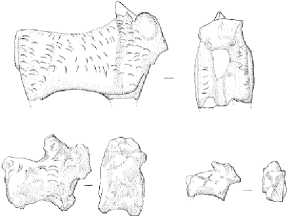
Figure 5
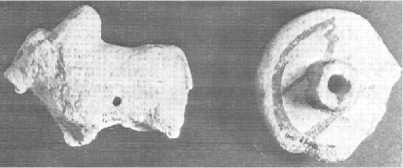
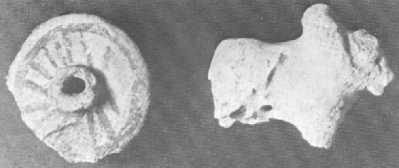
Figure 6
The hump of zebu of Shahr-i Sokhte figurines is often hypertrophied. Also two seal impressions with images of zebu were found there. Clay figurines of zebu are hardly placed in graves, only one bronze statuette of zebu was found in Burial 16. Figurines of zebu were made far from the central workshops, on some there are traces of completion already after production, others are flattened or deformed while being still not hardened as if during distant transportation, some were perforated even before hardening, there are some cuts and traces of erasure still in a soft state on many of the statuettes. All this, according to G. Santini, points at the fact that the making of these clay figurines was not intended to provide the final product, but was a reflection of some symbolic or ritual action performed in the process of modeling or immediately after it — which indicates the existence of the cult of zebu.
There was a series of successive settlements in the region to the West of Shahr-i Sokhte on the border between Western and Eastern Iran, on the mountain plain on the western edge of the Dasht-e Lut (the Lut Desert) near the city of Shahdad (Kerman) in 4000–1500 BC. Of them the one dating back to 2500–2000 BCE was a major handicraft and trading centre of this area. The acquaintance of their inhabitants with zebu is evidenced by a chlorite vessel with a carved image of this animal (2900–2600 BC) (Figure 7).
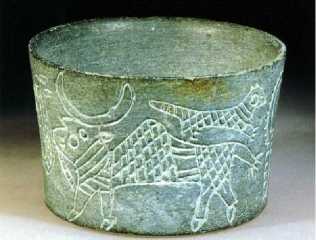
Figure 7
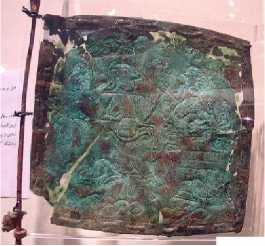
Figure 8
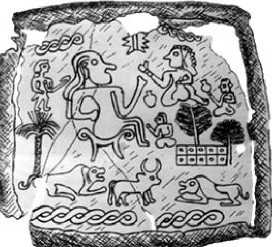
A bronze flag plate was also found there (circa 2400 BC). A zebu between two predators was embossed in the lower part of it (Figure 8). A stone vessel with zebus with relief protruding snouts carved on it (Figure 9)
®ф
Attribution LSlAtematisnal ГСС i¥4.0)
and a seal with images of two humped bulls (Figure 10) come from Kerman. A copper plate with a lying zebu embossed on it dating back to 2500–2000 BC originates from Shahdad (Figure 11).

Figure 9
Figure 10
Figure 11
Figure 12
The major centre of chlorite items’ production was Jiroft culture (Kerman). Its large settlement Konar Sandal existed in 2880–2200 BC in the valley of Halil Rud South of Shahdad and 28 km South of Jiroft. There are numerous vessels and a number of other chlorite objects from this area decorated with traced carvings with inlays of (semiprecious) stones and shells.
Very often they are images of humpback bulls and cows (Photographic Applications, Plate 4). Until 2000, when the Halil Rud flood uncovered sites with a large number of chlorite artifacts, such things had been designated as objects of "intercultural style", because they had been found in different regions of Southwest and Central Asia — for example, vessels with carvings of two zebus from Tarut island off the North-Eastern coast of Arabia in the Persian Gulf (the Metropolitan Museum of Art, 2014.717) (Figure 12) and from Agrab (or Aqrab) in the Diyala valley near Baghdad (Figure 13). Also a plate fragment of chlorite comes from the same Tell Agrab (Figure 14). According to Ph.L. Kohl’s map, chlorite objects with carved images of zebu on them were also found in Mari, Khafajah or Khafaje, Kish, Nippur, Adab or Udab, Ur in Mesopotamia, and at Susa in Elam, on the island of Failaka in the Persian Gulf and at Tepe Yahya in Kerman to the West of the Halil Rud.

Figure 13
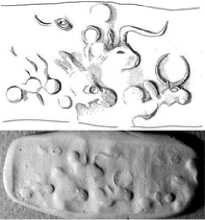
Figure 16
Figure 14
Figure 15
D. Frenez and M. Vidale described a unique chlorite plate on which the image of a humpback cow with a calf at the udder and a predator on its back is carved — and in front of it there is a large cup (Figure 15). According to the researchers, the whole composition is a remake of the famous Mature Harappan pattern with a unicorn bull at the drinker. The same authors analyzed a cylinder seal of marble greatly worn-out by stamping with images of bulls’ heads found at South Konar Sandal. It has carvings of a unicorn with a hump and a head of a zebu with two horns (Figure 16). The scholars are of the opinion that this Jiroft seal carver repeats the patterns of Mature Harappan seals, including creatures with three and more heads.
During the excavations of South Konar Sandal a damaged cup with a zebu drawing was found (Figure 17). A small figurine of zebu from lapis lazuli comes from the region of Halil Rud (Figure 18). Moreover, there is a chlorite vessel, now exhibited in the Archaeological Museum of Jiroft, which has carvings of a bull with a hump and only one horn (Figure 19). All this points at the strong relationship between the Indus cultures and Jiroft and the powerful influence of the former on the civilization of the latter.

Figure 17
Figure 18
Figure 19
Let us consider the evidence of migration along the Northern route through the territory of the Bactrian– Margian archaeological culture (2300–1600 BC). It yields a number of zebu images: on the damaged chlorite seal from Togolok 21 (boundary of III–II Millennia BC) (Figure 20), on one side of the two-sided stone seal from the old delta of Murgab (Figure 21), on the Bactrian–Margian seals with images of a zebu and snakes (figure 22), a statuette of zebu found on the surface of Gonur I site.

Figure 20 Figure 21
Figure 22
At Gonur Depe three clay figurines of humped bovines (trench 18, Room 161; the top layer of the trenches 17 and 22) were found also (Figure 23). Zebu is depicted on the seal from the settlement of Taip 1 (Figure 24). A stick figure from the cult vessel in the shape of a zebu was excavated from one of the looted graves of Bactria (Figure 25). A similar statuette was found at Togolok 21 site (Figure 26). The close cultural and population relations of the Indus valley with the South of Central Asia are well known.
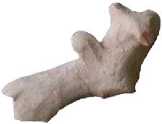
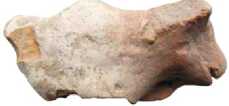
Figure 23
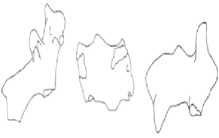
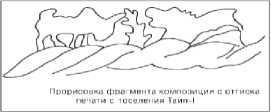
Figure 24
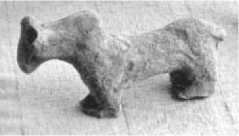
Figure 25
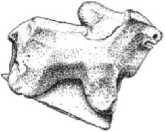
Figure 26
Bactria–Margiana, Gorgan, Sumbar, Tepe Sialk, Hissar III, Shahdad, Jiroft, Tepe Yahya to the SouthWest of Halil Rud, Baluchistan and Makran should be included in the formative area of the ancient Iranian ethnos, into which native speakers of Indo-Aryan languages autochthonous in the North-West Hindustan constantly poured from the Indus valley.
The collapse of the civilization of Mature Harappa circa 2000–1900 BC caused the new wave of migration of some of its carriers — warriors and zebu breeders — to the West up to Syria and Anatolia. Numerous images of humpback bulls — endemics of South Asia — dating back to the first half of the II Millennium BC and later were found during excavations of archaeological sites of the (North-)Eastern Mediterranean. A clay form for baking bread from the palace in Mari on the Euphrates with an image of a lion attacking zebu stored in the Louvre (AO18902) (Figure 27) dates back to the beginning of the II Millennium BC. A hematite cylinder seal from Syria depicting a humped bull held in the Louvre (AO3757) (Figure 28) dates back to the XVIII century BC. The palace of the king of the state of Mari Zimri-lim (1775–1761 BC) was decorated with mirror frescoes of two humpback bulls (the Louvre, AO19826) (Figure 29).

Figure 27
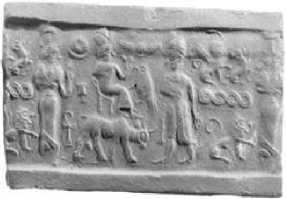
Figure 28
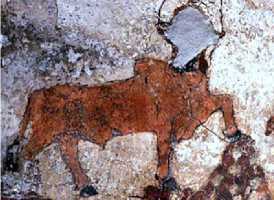
Figure 29
There is an image of two lions standing with their front paws on a zebu bull on the hematite cylindrical seal from the Louvre (AO10855), dating back to the XVII century BC (Figure 30). A clay figurine of a zebu (circa 1700 BC) held in the British Museum (125500) was discovered in Chagar Bazar (Syria) (Figure 31). Sixteen more fragmented statuettes of zebus were excavated at the same site. A clay figurine of a humped bull was found in Umm el-Marra (northern Syria) (Figure 32). A clay statuette of a zebu bull from Tepe Gawra (24 km northeast of Mosul, Iraq) dates back to 1500 BC or a little earlier (Figure 33). Late Bronze Age deposits at Tell Munbaqa in north Syria yielded many clay zebu figurines (Figure 34).
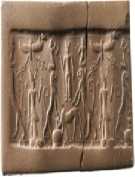
Figure 30
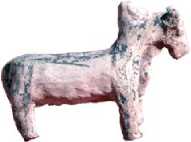
Figure 31
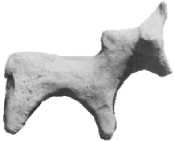
Figure 32
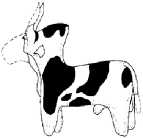
Figure 33 Figure 34
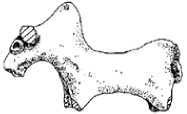

Figure 35
Five zebu figurines (Figure 35) were excavated at Tell Brak site (north-eastern Syria). A seal with an image of two lions attacking a bull–zebu (Figure 36) comes from the temple of Ishtar–Shavushki in Nuzi (Yorghan Tepe, Iraq, near the Tigris river). The discovery of the sealing with the inscription ‘Shaushtatar, son of Parshatatar, the king of Mitanni’ (circa 1440 BC) is extremely important. It was also used later by at least four generations of kings of this state with Indo-Aryan names. The impressions of this seal were found on tablets with the texts mentioning the ruler and his donations of villages in the region from the eastern bank of the Tigris to the western bank of the Euphrates in the settlements of Nuzi, Umm el-Marra, Tell Brak and Tell Bazi (northern Syria). This seal depicts the slaughter of a one-horned zebu in the upper corner (Figure 37). Thus it combines two images of Rigveda and Mature Harappa in a socially, politically and ritually significant context — that of a unicorn and that of a zebu. According to R. Matthews zebu figurines dating back to 2000–1000 BC were also found at Alalakh (in the Amuq River valley of Turkey's Hatay Province), Sabi Abyadh (northern Syria), Tall Hamad Aga (north Iraq) and Haradum (on the middle Euphrates). What is even more important, at Tell Hamida, in the Iraqi Jezirah, among the animal figurines there were twice as many zebu as other species in the Late Khabur – early Nuzi Ware (i.e. Mitannian) Period (1650–1550 BC).

Figure 36
Figure 37 Figure 38 Figure 39
Figure 40
A bronze statuette of a zebu from Tel Hazor (Israel, now in the Israel Museum, Jerusalem) (Figure 38) dates back to 1500–1200 BC. A hollow bronze figurine of a zebu from Tel Beth-Shemesh (Israel) (Figure 39) dates back to 1400–1200 BC. The Louvre houses a number of clay statuettes of zebu from Emar (Tell Meskene, Aleppo Governate, northern Syria), dating back to 1300–1200 BC (AO26865, AO26867) and 1300–1150 BC (AO26838, AO26864, AO26868, AO26870, AO26899). A clay figurine of a humped bull from Cyprus (Sinda necropolis, the Louvre, AM1631) dates back to 1230–1050 BC (Photographic Applications, Plate 5). A bronze statuette of a zebu from Dhahrat et-Tawileh (Palestine) (Figure 40) dates back to the XII century BC.
A relief of the temple of Ramesses III (1186–1155 BC) in Medinet Habu depicts four carts of the Sea Peoples invading Egypt drawn by humpback bulls (Figure 41).
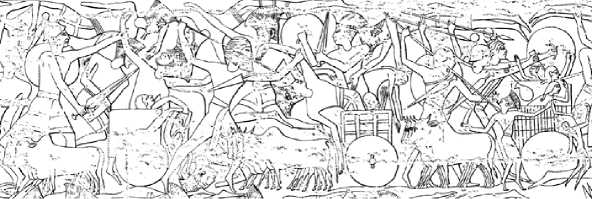

Images of zebu were common in the same era in the Hittite kingdom. A relief vase from Hüseyindede (Yörüklü in the Turkish province of Çorum) with a painted decoration in the form of four humpback bulls (Figure 42) belongs to the Old Hittite period (XVI century BC). Also two early Hittite seals were found — an attacking zebu bull can be seen on the top of the first and a pair of opposing humped bulls is placed at the bottom of the second (Figures 43).
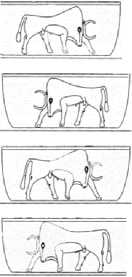
Figure 42 Figure 43
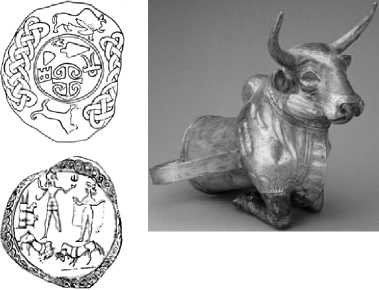
Figure 44
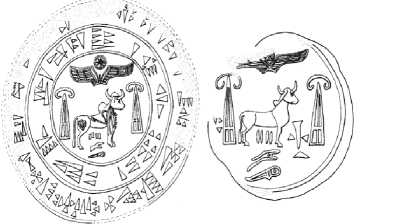
Figure 45
Hittite silver drinking vessel (rhyton) in the form of the front half of the body of a humpback bull kneeling on its front legs dates back to 1400–1200 BC (the Metropolitan Museum of Art, New York, 1989.281.11) (Figure 44). A large terracotta figurine of a zebu bull with small holes on the chest, the front and the back of the neck was found in Bogazköy and dates back to 1400–1200 BC. It is now stored in Berlin in the Museum of southwestern Asia. There is a humped bull on the royal seals of Muwatalli II (c. 1295–1272 BC) (Figure 45).
The joint seals of Muwattalli II and Tanuhepa also depict a humped bull (Figure 46). The figure of the bull is a hieroglyph and a part of the name of Muwatalli (syllabogram "mu"), but it is important that the king preferred to use the image of the zebu bull to write his name. In some Hittite images, the humpback bull represents the god of the storm. In the name of Muwatalli II, the image of the bull also functions as a symbol of the god of the storm - the personal patron of the ruler, whose power is manifested in the power of the king. Signs on the figure of the bull on the seals of Muwatalli II are found only on the images of the bull, calf and deer — i.e. animals– representatives of the god of the storm and the god of the fields — which emphasizes the sacred character of the humped bull on the seals.

Figure 46
A bronze rod with an image of a humpback bull at the end (end of II Millennium BC) comes from Northern Iran, a clay zebu figurine (Figure 47) — from Haft Tepe (Elam), two clay statuettes of lying zebus dating from the reign of Untash-Napirisha (XIV century BC) (Figure 48) — from Tchoga Zanbil 40 km South-East of Susa (Elam, now in the Louvre (Sb5127, Sb5128)), two clay figurines of zebus dating back to 1400–1100 BC (now in the Louvre (Sb5800, Sb19323)) (Figure 49) — from Susa, a clay sculpture of a zebu (end of II thousand BC) — from the entrance to the ziggurat of Dur-Untash in Khuzestan (Figure 50).
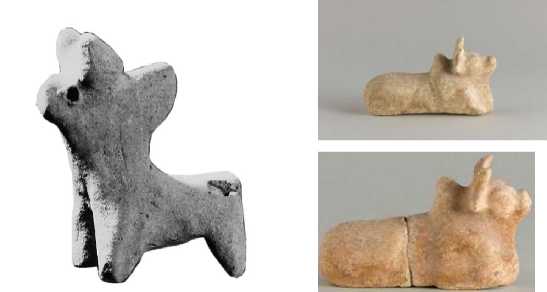
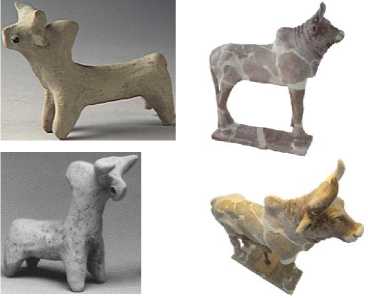
Figure 47 Figure 48 Figure 49 Figure 50
The region of Gilan South of the Caspian sea served as a staging point on the migration path of the carriers of Late Harappan culture from the North-West of the Indian subcontinent to the North-Eastern Mediterranean. Here in the military-aristocratic necropolis of Marlik Tepe on the river Gohar Rud near Rudbar and on a number of sites around it dozens of clay ritual vessels of Marlik archaeological culture were found. They are all in the form of humpback bovines with a spout instead of a muzzle. They date back to 1500–1000 BC. Now they are stored in museums all around the world (Photographic Applications, Plate 6). Obviously, another kind of vessel with a handle and a top in the form of horns and a hump of zebu with a spout instead of a muzzle belongs to the same ceramic tradition (Photographic Applications, Plate 6, the Smithsonian Institution). Only in 53 officially investigated graves of Marlik Tepe and in the vicinity of Geshlag nearby 17 clay vessels of red (10 items) and gray or grayish-brown (7 items) colour in the form of zebu with a hypertrophied hump were excavated (out of the total number of vessels — 31). Twenty-nine bronze figurines of humpback bulls or cows (out of the total number of animal statuettes — 68) were excavated at the same Marlik Tepe. Of them ten statuettes are paired in harness with or without a plow and one has wheels. A bronze pin with the decoration in the form of a humped bull and a seal with a handle in the form of a zebu were also found in Marlik. Two more bronze figurines of zebu come from Gilan (Photographic Applications, Plate 7) as well as a gold cup with several repetitive images of a cow or a bull with a small hump (Figure 51).

Figure 51 Figure 52 Figure 53 Figure 54 Figure 55
According to the chief excavator, humpback bulls had a special meaning for the people of Marlik. This is confirmed by the fact that a big hump, which was always hypertrophied, was added to the figurines of other animals such as deer (Figure 52) and rams (Figures 53–54), which do not have this body feature in real life, as well as to a ceramic vessel in the shape of a leopard and to a mountain goat on the handle of a bronze bell (Figure 55). According to estimates of Pilosaidi Katayun (2015), 32 clay vessels in the form of a zebu (out of the total number of 46 animal figurines found in Gilan) were described, catalogued and/or kept in museums. One figurine of a humped bull was mounted on four wheels (Figure 56).

Figure 56
Figure 57
Figure 58 Figure 59 Figure 60
The custom of the creators of Marlik Tepe to put images of humpback bulls and especially ritual vessels for libation in the form of a zebu into the graves (Figure 57) directly connects Marlikians with Late Harappan inhabitants of the North-West of South Asia. Terracotta figurines of humpback bulls were found in the cemetery of Sanauli (Western Uttar Pradesh, East of Yamuna) in the funeral inventory of the layers transitive from Mature to Late Harappa (2100–1800 BC). They served as handles for the covers of two clay vessels with funeral food (Figure 58).
Excavations in 2018 just in 100 m from the cemetery of the Late Harappa led to the opening of seven graves of the Ochre Pottery or Copper Hoards Culture with an approximate dating of about 2000 BC. A comb with a handle in the form of a zebu was placed in one of the graves (Figure 59). A polychrome rhyton in the shape of a humped bull (now kept in the Musée national des arts asiatiques in Paris), but with a throat on the back of the neck, comes from Baluchistan and dates back to prior 2000 BC (Figure 60). In addition, the creators of the Cemetery H in Harappa-on-Ravi decorated pots placed in graves with ornamental belts with black images of zebu on red background (Figure 61).
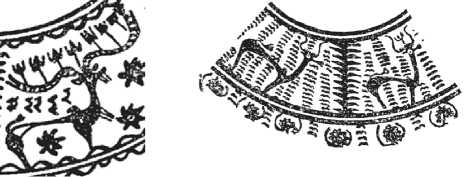
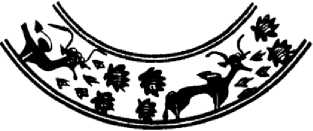
Figure 61
The tradition of casting single bronze figurines of zebu makes the culture of Marlik similar to the civilization of Mature Harappa, where such a statuette was found in Mohenjodaro (Figure 62).

Figure 65
Figure 62
Figure 63
Figure 64
The tradition of casting paired bronze statuettes of zebu teams, characteristic of the Marlikians, also directly echoes Late Harappan finds of the North-West of South Asia. A bronze composition of two zebus supporting a platform with a kneeling woman on it (2000–1750 BC) comes from Uttar Pradesh (Figure 63). A bronze chariot with a pair of humpback bulls that are part of the Daimabad Hoard (district Ahmednagar, Maharashtra) belongs to the Late Harappan epoch. (Figure 64)
®ф
Attribution LSlAtematisnal ГСС i¥4.0)
When drawing parallels between the archaeological culture of Marlik and Harappa, it should be pointed out that it is in Iranian Azerbaijan that the pure-blooded species of zebu, which is still very similar to the rock breeds of humped cattle of Afghanistan and Northern Pakistan, is found so far. There are stunted bulls humped like Indian zebu in the villages of Gilan and Mazandaran.
Some Kassite rulers of Babylonia had Indo-Aryan throne names. On the seal of the Kassite king Na-zi-Ma-ru-ut-ta-aš (translated as «Maruttaš protects him», around 1300 BC), — i.e. one of the rulers, whose throne name included a theonym borrowed from Indo-Aryan, — a plow with a pair of humpback bulls harnessed to it is depicted (Figure 65). By order of Kassite kings of Babylonia stone landmarks (kudurru) with carved images were created. On two kudurrus of Meli-Shipak or Melishihu (XII century BC) a hunchbacked ram (the addition of a hump of a zebu to another species) and a zebu are carved (Figure 66).

Figure 66
V. CONCLUSION
The spread of zebu cattle (depictions) from the Indus valley to the East Mediterranean region including Syria, Anatolia, Cyprus and Palestine correlates well with the present geographical distribution of human Y-haplogroups L-M11, R2 (R-L266) and R1a Z93 originating from Hindustan and of South Asian human genome K5 and South Indian human genome K16.
Both sets of data correlate with maps showing the relative proportions of zebu admixture in the three genomic components (mitochondrial, autosomal and Y-chromosomal) from the present day cattle populations across the Near East. These human population and domestic humped cattle movements are to be connected with the dispersal of Indo-European languages (spoken — Indo-Aryan and Iranian — and extinct — Kassite and Mitanni Aryan and Anatolian) from Hindustan to Asia Minor in 7000–1000 BC.


